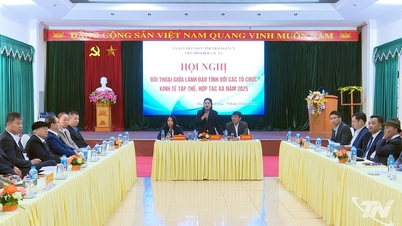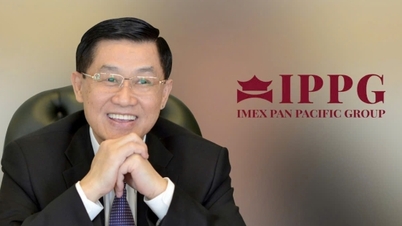ESG governance using technology, especially AI and digital transformation, is becoming an inevitable trend. However, many Vietnamese businesses are still struggling to implement it due to lack of data, human resources and infrastructure.
Dan Tri reporter had a conversation with Dr. Le Thai Ha, member of the Vietnam ESG Forum Appraisal Council, Executive Director of Vinfuture Fund, to learn about practical solutions, from building an ESG data platform, standardizing processes, to forming a comprehensive support ecosystem, helping businesses overcome challenges and seize golden opportunities in the digital age.
This year, the Vietnam ESG Forum, organized by Dan Tri newspaper, has the theme “ Science and technology and driving forces for sustainable development”. The forum brings together scientists, business leaders and policy makers to discuss, share experiences and seek breakthrough solutions.
“Golden key” for Vietnamese enterprises to integrate globally
In the current context, how do you assess the importance of ESG governance using technology, especially the application of artificial intelligence (AI) and digital transformation for Vietnamese enterprises?
- ESG governance using technology – especially AI and digital transformation – is increasingly vital for Vietnamese businesses. Not only to meet global standards, this is also a strategy to improve competitiveness, risk management and sustainable development.
First, ESG is increasingly becoming a default standard in investor assessments, international partners, and in global policies such as the EU's Carbon Border Adjustment Mechanism (CBAM).
Digital transformation acts as a “driving force” to help realize ESG goals, through the collection, processing and reporting of data in a transparent, systematic and verifiable manner. AI - especially new generation models - helps businesses process big data collected from sensors, IoT (Internet of Things) systems and satellite data; thereby supporting automatic emission monitoring, resource optimization and forecasting of environmental and social risks with high accuracy.
Second, reality shows that many Vietnamese businesses – especially small and medium-sized enterprises – still face difficulties in implementing ESG due to lack of data, specialized human resources and digital infrastructure. This is the space where technology can create a breakthrough: supporting the digitization of ESG data, which is currently scattered and unstandardized, and simplifying the assessment and reporting process.
Several recent surveys also show that applying AI to ESG management helps businesses increase operational efficiency, better control risks and optimize costs.
However, technology is just a tool. More important is strategic thinking and commitment from leaders. Enterprises need to build a roadmap to integrate ESG with digital transformation, invest in internal data platforms, train capacity and possibly set up an ESG data center to serve decision-making.

In the next 5-10 years, the combination of ESG, digital transformation and AI will no longer be a competitive advantage but will become a necessary condition for businesses to integrate into the global value chain, access green capital and achieve sustainable development goals. This is an opportunity, but also a strategic challenge that requires early and drastic action.
Could you please elaborate on the concept of “ESG governance using technology”? Specifically, what technologies can be applied and how to apply them in each of the ESG pillars E (Environment), S (Society) and G (Governance)?
- The phrase “ESG governance with technology” can be understood as the application of digital technologies - especially AI, IoT, and big data - to support businesses in achieving environmental, social and governance goals in an effective, transparent and measurable manner.
Unlike the traditional approach which relied heavily on manual reporting and periodic data, today's technology allows businesses to monitor ESG indicators in real time, make data-driven decisions and report transparently according to international standards.
This is not only operational optimization, but also the foundation for improving long-term competitiveness.
Specifically, in terms of environment (E), businesses can use IoT sensors to track greenhouse gas emissions, combining AI and satellite data to detect deforestation or methane leaks - issues that were previously difficult to monitor.
AI also helps optimize energy consumption, process waste and build smart resource management systems.
On the social (S) side, technology helps assess employee satisfaction, gender equality and workforce diversity through internal data analysis. AI also helps assess the social impact of projects, or expand access to education and healthcare for disadvantaged communities – especially in rural and remote areas.

Today's technology enables businesses to monitor ESG metrics in real time, make data-driven decisions, and report transparently according to international standards.
In terms of governance (G), AI tools can automatically aggregate and analyze ESG data from multiple sources to create reports according to GRI, TCFD, or CSRD standards. In addition, AI-based risk management systems are being used to detect fraud, monitor compliance, and prevent misconduct within organizations.
So, technology doesn't replace ESG - it makes ESG more accurate, transparent and effective.
According to a recent report by Deloitte, AI is becoming a core tool to help businesses meet mandatory ESG reporting requirements. In Vietnam, a survey by FPT Digital also showed that properly integrating technology into an ESG strategy can help businesses save 10-30% of costs.
This is not just a trend, but a strategic opportunity that Vietnamese businesses need to grasp early to avoid falling behind in the race for integration and sustainable development.
Opportunities and challenges
According to the Doctor, what are the biggest opportunities and challenges when Vietnamese enterprises deploy AI applications and digital transformation technologies in ESG implementation?
- The application of AI and digital technology to ESG implementation is opening an important transformation period for Vietnamese businesses. If looking at the region, this is an opportunity for Vietnam to shape its ESG strategy from the beginning, integrating it into the digital transformation process - instead of just passively complying like many other countries.
In terms of opportunities, the first point is the ability to improve global competitiveness. ESG transparency through technology – especially with tools such as AI, blockchain or IoT – helps businesses not only meet requirements such as CBAM of the European Union (EU), but also create trust with investors and international partners.
Second, Vietnam currently has a rapidly growing technology ecosystem with the participation of large enterprises such as Vingroup, FPT, and a young, adaptable workforce. This is a favorable foundation for deploying ESG-AI solutions suitable for real-life conditions.
For example, Vingroup has pioneered many digital initiatives to serve ESG. Typically, VinFast has completely converted from gasoline vehicles to electric vehicles, integrating technologies such as voice assistants, ADAS systems, and Smart Services; or TechnoPark Tower in the Vinhomes Ocean Park project uses nearly 3,000 IoT sensors to intelligently control light, temperature, and CO2.

The Internet of Things plays a big role in helping businesses manage ESG with technology (Photo: ST).
These solutions not only help reduce emissions and save energy, but also create a foundation for digital and transparent ESG reporting according to international standards.
However, the challenge remains large. Many businesses, especially SMEs, lack the human resources capable of integrating ESG and technology.
The initial investment costs for data infrastructure, AI or ESG management software are still high, while short-term financial benefits are not easy to quantify. In addition, we also lack a unified ESG standard in the country – making it difficult for businesses to determine which indicators to monitor and report.
Finally, technology itself – especially AI – poses risks if left unchecked. The application of AI in ESG needs to be accompanied by ethical principles, algorithmic transparency, and monitoring of the environmental impact of the technology itself.
I believe that if there is a step-by-step approach - starting from standardizing ESG data, training internal human resources, and then gradually integrating appropriate technology - Vietnamese enterprises can completely take advantage of this "technology push" to not only transform sustainably, but also build long-term competitive advantages in the global value chain.
To support businesses, especially small and medium enterprises (SMEs) in applying AI to ESG, what suggestions do you have on addressing legal barriers and digital capacity?
- The application of AI to ESG is gradually becoming an inevitable trend in the sustainable development roadmap of enterprises, especially SMEs - which are under increasing pressure from export markets, investors, as well as requirements for information transparency. However, the implementation process still faces many barriers.
First of all, it is necessary to continue to perfect the ESG guidance framework suitable to Vietnam's conditions, while creating more mechanisms to encourage businesses to actively participate, instead of just approaching it from a compliance perspective.
According to a survey by the State Bank of Vietnam and related organizations (SBV, 2024), more than 70% of small and medium-sized enterprises have never published ESG reports, and 67% have not identified suitable ESG indicators to monitor. This shows a great need for a support system, including finance, training and technical advice.
In particular, recent policies such as Resolution 68 have provided very positive directions – for example, supporting tax incentives, green credits, and promoting the formation of domestic technology platforms to measure emissions and standardize ESG data.
This is a good premise for businesses, especially SMEs, to proactively approach and start the process of integrating ESG - AI into business operations.
In terms of digital capabilities, many SMEs currently do not have a dedicated ESG team or a strong enough technology department to deploy complex solutions.

It is difficult for any SME to implement ESG using technology alone.
Therefore, I think we should develop user-friendly digital platforms, such as what Singapore is doing with the GPRNT system, to simplify ESG collection, standardization and reporting. In parallel, we can expand free ESG training programs for businesses - from awareness to specific practices in each industry.
Ultimately, it is difficult for any SME to implement ESG technology alone. It is necessary to form a comprehensive ESG ecosystem where industry associations, business support centers, consulting organizations and ESG advisory networks play a connecting role - sharing experiences, accompanying and minimizing risks in the process of green transformation and digitalization of ESG.
Overcoming data “resistance”: What is the solution for Vietnamese SMEs?
How do you assess the readiness of Vietnamese enterprises in building ESG data infrastructure today?
- Currently, the readiness level of Vietnamese enterprises in building ESG data infrastructure is generally still in the initial stage - with many positive commitments but a clear gap between intentions and specific actions, especially in the SME group.
A recent survey by PwC Vietnam shows that up to 80% of businesses have or are planning to implement ESG. However, only about 44% of large businesses have a clear plan, while in the SME sector, this figure is only 25%, while more than 20% of businesses said they do not have an ESG plan in the next 2-4 years.
Among them, the construction and management of ESG data is a prominent, systematic and specific challenge. Many businesses still collect ESG information manually or in a distributed manner, mainly on Excel, without a centralized, standardized or independently audited data system.
It is estimated that up to 70% of businesses have never published an ESG report, and only about 15% of existing reports have achieved a level of transparency that can be compared with international standards. This shows that ESG data infrastructure – including technology, processes and human capacity – remains a major bottleneck.

However, we are also witnessing positive movements from the perspective of awareness and strategic orientation.
Some pioneering enterprises - especially many FDI enterprises, listed companies and financial institutions - have seriously invested in ESG measurement and reporting systems according to international standards such as GRI, ISSB or CSRD. These will be important models to spread and create momentum for the entire business ecosystem.
Overall, we have positive signals in terms of awareness and orientation, but to be truly ready for ESG data, Vietnamese businesses need to make long-term investments in digital platforms, data collection and verification processes, and capacity building of the responsible team.
This is not only a compliance requirement in the new context, but also a foundation for improving risk management capacity, attracting green capital flows and effectively integrating into the global supply chain.
According to the Doctor, why is it important to build an ESG Data Platform in a business and what key factors need to be considered when building this infrastructure?
- Building an ESG data platform is not only a compliance requirement, but is increasingly becoming a core strategic element in corporate governance and sustainable development.
In a context where disclosure standards such as ISSB (International Sustainability Standards Board), ESRS (European Sustainability Reporting Standards), or TCFD (Task Force on Climate-related Financial Disclosures) are being widely applied globally, businesses cannot continue to rely on fragmented, disjointed and unconnected data systems.
Instead, there is a need to establish a centralized platform that is capable of collecting, processing, verifying and reporting ESG data in a transparent, verifiable and easily traceable manner.
An effective ESG data platform will help businesses create a unified data system that simultaneously serves multiple goals - from internal governance, reporting to investors, to communicating with stakeholders.
The system also enables the automation of data aggregation from multiple sources – such as Enterprise Resource Planning (ERP), Customer Relationship Management (CRM), IoT sensors, and human resource records – reducing manual errors while saving time and operational costs.
More importantly, the ability to continuously monitor ESG indicators will help businesses proactively identify risks, adjust strategies and better meet the requirements of global supply chains.
However, to build a truly effective platform, businesses need to consider several key factors. First and foremost is integration – the system must be flexible enough to connect with existing platforms and adapt to future expansion needs.
Second is the ability to update and comply with international standards, especially in the context of constantly changing sustainability reporting requirements. Third is the ability to be transparent and independently audited, to ensure reliability and data protection. A user-friendly interface - especially for SMEs - is also important to reduce technical barriers and training costs.

Security needs to be a top priority, as ESG data is often related to resources, human resources and governance – strategic assets of the business.
Finally, security needs to be a top priority, as ESG data often relates to resources, human resources and governance – strategic assets of the business.
In fact, some large enterprises in Vietnam such as Vingroup, Vinamilk, and ACB have begun to seriously invest in integrated and digital ESG data systems, allowing them to continuously monitor emissions, employee satisfaction, management efficiency, and supply chains.
This proves that the ESG data platform is no longer a theoretical concept, but is gradually being realized in the process of digital transformation and global green market integration.
- How can businesses effectively share ESG data along the value chain, especially connecting leading businesses and suppliers?
Effective ESG data sharing across the value chain is becoming a must, especially as standards such as the EU CSRD/ESRS and the International Sustainability Standards Board (ISSB) IFRS S2 require comprehensive reporting, including Scope 3 – i.e. environmental and social impacts across the entire supply chain.
To effectively connect upstream businesses and suppliers, it is essential to build an integrated ESG data system that allows direct connection to operational platforms such as ERP, CRM or procurement systems, thereby automating the process of data collection, aggregation and verification.
Businesses can start by developing a set of ESG criteria specifically for suppliers, along with standardized reporting templates according to GRI or ESRS. At the same time, there should be a policy of technical support and training to improve the capacity of partners in the chain to collect and share ESG data.
The establishment of internal ESG Centers of Excellence will also help standardize processes, monitor quality and ensure the up-to-dateness of value chain data.
In addition, the chain cooperation model - instead of the individual audit approach - is increasingly proving effective.
Initiatives such as Together for Sustainability (TfS) in the chemicals industry or OpenSC in agriculture show that when upstream companies take a leadership role and establish transparent mechanisms for sharing ESG data (e.g. integrating ESG criteria into supply contracts), not only does reporting efficiency increase, but it also significantly supports Scope 3 emissions measurement and reduction.
In Vietnam, although ESG data sharing remains fragmented, some export enterprises – particularly in the textile, electronics and agricultural sectors – have begun to implement traceability systems and supply chain ESG reporting.
This will be an important foundation for Vietnamese enterprises to improve their compliance capacity, increase competitiveness and adapt to increasingly stringent international regulations in the coming time.
Thank you for taking the time to chat, Dr.
Source: https://dantri.com.vn/cong-nghe/quan-tri-esg-bang-cong-nghe-co-hoi-nao-cho-doanh-nghiep-viet-20250802111259942.htm













































































































Comment (0)